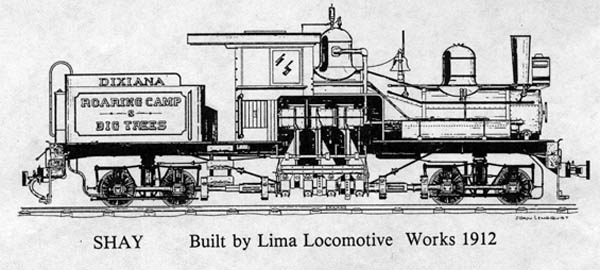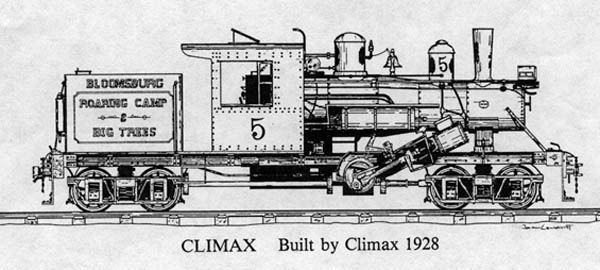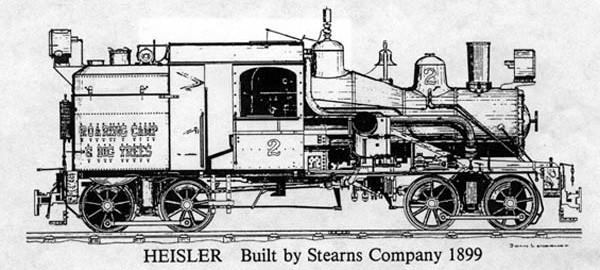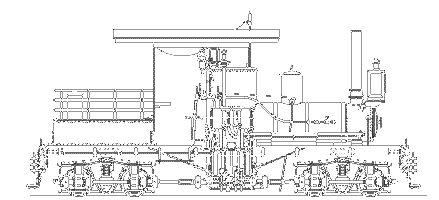Garrattfan's Modelrailroading Pages

Articulation
Geared steam locomotives - a general introduction
A geared steam locomotive uses reduction gearing in the drivetrain, as opposed to the common directly driven design. The locomotives use conventional adhesion to provide traction and therefore should not be confused with rack railway locomotives which drive a cog along a rack to provide traction.
On a common steam locomotive the cylinders drive one wheelset directly via the connecting rod and other driving axles are coupled to the main driving axle via a coupling rod. This arrangement necessitates a more or less rigid position of all coupled axles in one horizontal plane. There is no (radial) play in the horizontal plane and just so much as is needed for an adequate suspension in the vertical plane. This in turn demands the track to be in the same plane, regular and flat. This property of the conventional rigid frame steam locomotive proved a nuisance on logging railroads. The track was hastily laid on whatever ground was available and with whatever materials where available. The railroads were temporary so there was no time and money to lay them properly. The ever undulating logging railroads caused rigid frame steam locomotives to lift its wheels off the track easily and derail. That rendered conventional steam locomotives with a long wheel base utterly unsuitable for logging railroads. Locomotives with a short wheelbase however where usually of limited power. Workers in the logging industry were struggling with this dilemma.
Epraim Shay, though namesake to the locomotive, is technically not the inventor. He owned a logging company and saw how his workers struggled to find a working alternative for the conventional locomotve by placing the boiler of an flat car powering the trucks via chain. This was a vulnerable and cumbersome solution. Shay set to work, picking up the idea of a locomotive with trucks. This resulted in his wel errrm Shay locomotive ;-) the progenitor of a sprawling design family based on by and large the same principles laid down by Ephraim Shay. The first Shay was built in 1880.
The vast majority of geared locomotives in the world were built to one of three distinct designs, whether licensed and official, or clones built after the expiration of key patents. Of the types, the Shay locomotive was the most numerous and best known. The overwhelming majority operated on the North American continent, but with a number in use in various parts of South America and a fair number in Australia and New Zealand, including home-developed types.
This 13 ton SHAY LOCOMOTIVE is typical of the period from
1880-1904 for an early small size Geared Locomotive. |
This newly invented engine had many advantages for logging
|
This all came at a price though as geared engines were slow runners, reaching top speeds at about 16 mph.
The majority of the geared locomotives was constructed after three basic principles. The is the original of the geared locomotive is the Shay. Frankly I think the Heisler and the Climax were invented to circumvent the patents of Lima. Still the Heisler and the climax had their distinct advantages over the Shay. I will briefly compare the three.
 |
The Shay has the engine and the drive train on the right hand side. To counterbalance the weight of the engine the boiler is offset to the left. The majority of the Shays was built with a three cylinder engine which gives more uniform power distribution and a better balancing of the engine. Advantage: The absence of a center drive shaft allowed for a spacious firebox |
 |
The Climax has a conventional cylinder arrangement albeit steeply placed to give the front truck sufficient room. The cylinder drive a jackshaft that is connected to gear box. Via a central drive shaft the trucks are powered. The Climax Advantages:
|
 |
The Heisler has a central drive shaft. Two cylinders are arranged in a V-shape under the boiler and power the drive shaft directly without gears. Only on axle of each truck was geared. Advantages:
Setbacks:
|
The Shay and other geared locomotives have been described in detail in many publications and internet site. I see no good in copying all this information just for the sake of keeping you on my site. Do visit the other sources and please return to my site ;-)
- Wikipedia on Geared Steam Locomotives
- http://www.gearedsteam.com/
- Shay Locomotives
- Climax Locomotives


Sign my
GuestBook